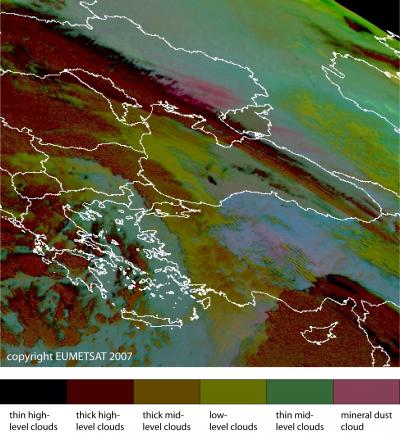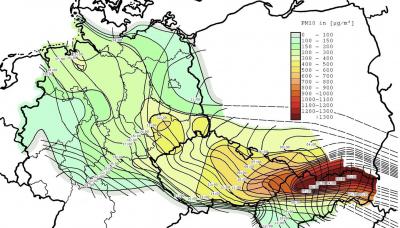Fallow agricultural land and steppe-formation processes are evidently capable of having a much greater effect on global air quality than was previously assumed, according to researchers who examined a dust cloud that formed over parched fields in southern Ukraine and led to extremely high concentrations of particulate matter in Central Europe.
Over two-thirds of the land area in the Ukraine consists of fields and meadows. The soil on 220,000 square kilometres is regarded as being under threat. Since the 1930s wind erosion in what was then the Soviet Union has increased considerably as a result of collectivisation in agriculture and the resultant large field areas.
In particular, this has affected the regions north of the Caucasus, the lower reaches of the Don river and eastern and southern Ukraine. It is possible that the process is also accelerated by climate change. In particular, previously unaffected semi-arid regions are continuing to dry out.

A normal dust storm can result in 70 tons of the light black soil being whirled up per hectare per hour.
On 24 March 2007 the dust cloud spread across Slovakia, Poland and the Czech Republic to Germany. Peak concentrations of between 200 and 1400 micrograms of PM10 particulates per cubic metre were measured. By way of comparison: the EU daily average limit is 50 micrograms per cubic metre. Even if such meteorological conditions would appear to occur relatively infrequently, the unexpected scale of the phenomenon showed a need for a better understanding of the processes that lead to the formation and transport of such large quantities of dust.
Writing in the journal Atmospheric Chemistry and Physics, the researchers from the Leibniz Institute for Tropospheric Research (IfT), Freie Universität Berlin, the Helmholtz Centre for Environmental Research (UFZ) and Saxony’s regional office of the environment and geology (LfUG) explain that this is particularly relevant in the context of human-induced desertification and climate change. Previously, the Sahara had been seen as the main source of dust carried over long distances to Central Europe. The paper published by the research team from Leipzig, Berlin and Dresden is the first documentation of dust transport from the Ukraine.
The black soil in the south of the Ukraine is one of the most fertile soils in the world, but it is also very fine and therefore particularly sensitive to erosion. On 23 March 2007, gusts of wind with speeds of up to 90 kilometres per hour whipped up huge quantities of dust in the steppe. A dust cloud formed that was so large that it was later clearly visible on the weather satellite infrared pictures.
Due to an area of high pressure over Scandinavia and an area of low pressure moving from the Black Sea to Italy, the air mass quickly drifted to Central Europe. Just one day later the air with its cargo of fine dust from the Ukrainian fields had arrived in Germany.

In Germany, people in the Erz Mountains noticed the sky had a slightly yellow sheen. The controllers noted that their filters were a much browner colour than usual. In the offices of the particulate experts at the Leibniz Institute for Tropospheric Research, Dr Wolfram Birmili and his colleagues quickly ruled out the classic air pollutants, such as coal-fired power stations and forest fires, because their measuring instruments showed unusually high levels of coarse-grained particles (larger than 0.001 mm) in the dust plume. The relatively low carbon monoxide and carbon dioxide concentrations also seemed to rule out industrial sources and biomass combustion.
Dust from the Sahara Desert had caused problems in the past the wind was coming from the east. The detective work began.
The directive on particulate matter has been in force in the European Union since 2005. As a consequence, there is a comprehensive air monitoring network in the member states designed to monitor compliance with the limit values. With quick, unbureaucratic assistance from a total of 15 state environmental agencies it was possible to analyse particulate data from 360 stations in five countries. It quickly became apparent that the particulate matter was coming from the east because the concentration increased noticeably towards Slovakia.
The researchers combed satellite pictures and came across what they were looking for on a EUMETSAT picture. This showed a noticeable red patch over southern Ukraine on 23 March which expanded rapidly. The researchers estimated the total mass of the dust cloud to be at least 60,000 tons. That is equivalent to more than 600 wagonloads of sand. The actual mass was probably much greater still, since the measuring devices register only those particles that are smaller than 10 microns (0.01 mm). Czech geologists estimated the total dust load must be about 3 million tons because this Ukrainian "plume" contained also bigger particles till size of 0.5mm.
The last remaining doubts about the origin of the dust cloud were cleared up by a team led by Dr Jindrich Hladil at the Institute of Geology of the Czech Academy of Sciences in Prague. They compared the dust samples from the air with dust samples taken directly from the Ukrainian soil. The lead isotope ratio showed that the dust had indeed come from the Black Sea region. “The mineralogical-petrological fingerprinting of the solid particles over 10 micrometre size can say a lot about the geologically specific source areas”, says Jindrich Hladil.

Moreover, the researchers in Prague, who were investigating the mystery completely independently of their counterparts in Leipzig, discovered in their samples pollen grains that were typical for the Ukraine. These included relatively large quantities of ragweed pollen, which is regarded as extremely allergenic. This also ruled out a dust storm from the Mediterranean coast of Libya, which had caught the scientists’ attention in the meantime. The rapid transport of the air and the presence of a temperature inversion, which acted like a lid, ensured that the dust cloud was unable to escape upwards or sideways – this was shown by data from a LIDAR remote sensing system in Leipzig and from weather balloons. It was swept to Germany as if through a pipe at speeds of up to 70 kilometres per hour, and was even detected in Britain.
"At the end of the day, it was the combination of dry, vulnerable soil, strong gusts of wind and fast transport within a dry, stable boundary layer that made this a freak dust event in Central Europe," explains Wolfram Birmili.
"According to Russian studies, in the past 40 years there have been three to five such dust storms per year on average in the Ukrainian steppe," Birmili reports. "Our institute has been constantly monitoring the airborne particles and their components at the Melpitz research station near Leipzig for around 15 years. We analysed all these measurements again retrospectively but were unable to detect any comparable dust cloud from the Black Sea area. This makes the dust cloud of 24 March 2007 unusual."
The research findings put a new complexion on the attempts being made by many local authorities to comply with the particulate limits using a wide range of measures.
In the greater Berlin area, scientists estimate that half of the particulate volumes come from regional and remote sources, rather than from local sources. Besides salt particles, soil particles form the largest mass of particles in the atmosphere. Scientists estimate that there are between 1,000 and 2,000 million tons of dust circulating around the world in the lower layers of the atmosphere in annual totals. This would be equivalent to the cargo of a goods train long enough to encircle the globe five times.
This particulate matter comes primarily from arid areas and deserts, i.e. from the Sahara, the Arabian peninsula, the Gobi Desert and the Taklimakan Desert in Asia, and the deserts in Australia and South America. One-fifth is believed to be caused by human activity, such as field cultivation. And there are consequences for the climate because dust particles in the air block solar radiation trying to enter the atmosphere and block heat radiation escaping into space and are therefore the largest unknown factor in climate models.
Moreover, not much is known about the possible health impacts of such long-distance transport of dust aerosols.
Publications:
Birmili, W., K. Schepanski, A. Ansmann, G. Spindler, I. Tegen, A. Nowak, E. Reimer, I. Mattis, K. Müller, E. Brüggemann, H. Herrmann, A. Wiedensohler, A. Schladitz, T. Tuch, und G. Löschau (2008), An episode of extremely high PM concentration over Central Europe caused by dust emitted over the southern Ukraine.
Atmos. Chem. Phys., 8, 997-1016. http://www.atmos-chem-phys.net/8/997/2008/acp-8-997-2008.pdf
Hladil, J., Strnad, L., Salek, M., Jankovska, V., Simandl, P., Schwarz, J., Smolik, J., Lisa, L., Koptikova, L., Rohovec, J., Bohmova, V., Langrova, A., Kocianova, M., Melichar, R., Adamovic, J. (2008 in press): An anomalous atmospheric dust deposition event over Central Europe, 24 March 2007, and fingerprinting of the SE Ukrainian source. Bulletin of Geosciences, 83, (2), pp. 1-32. http://www.geology.cz/bulletin/contents/articles-in-press/bullgeosci2008...





Comments